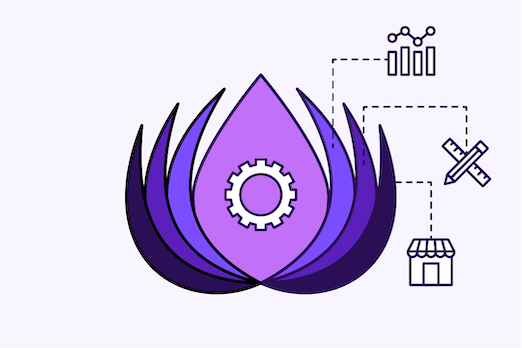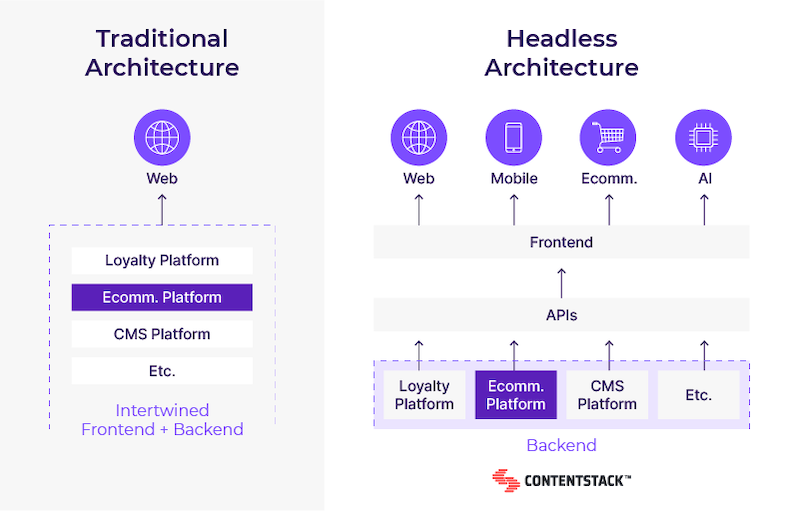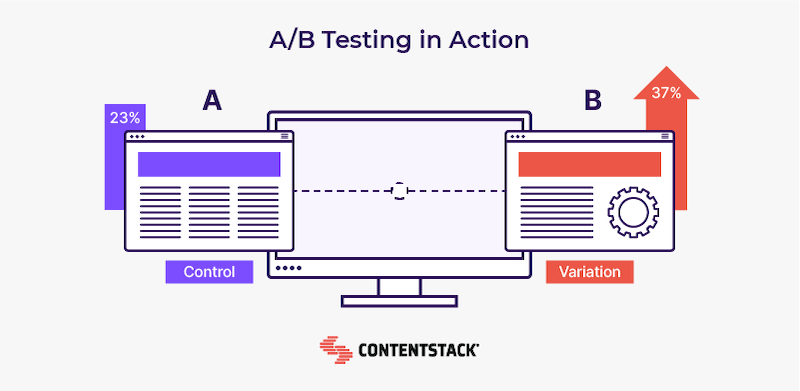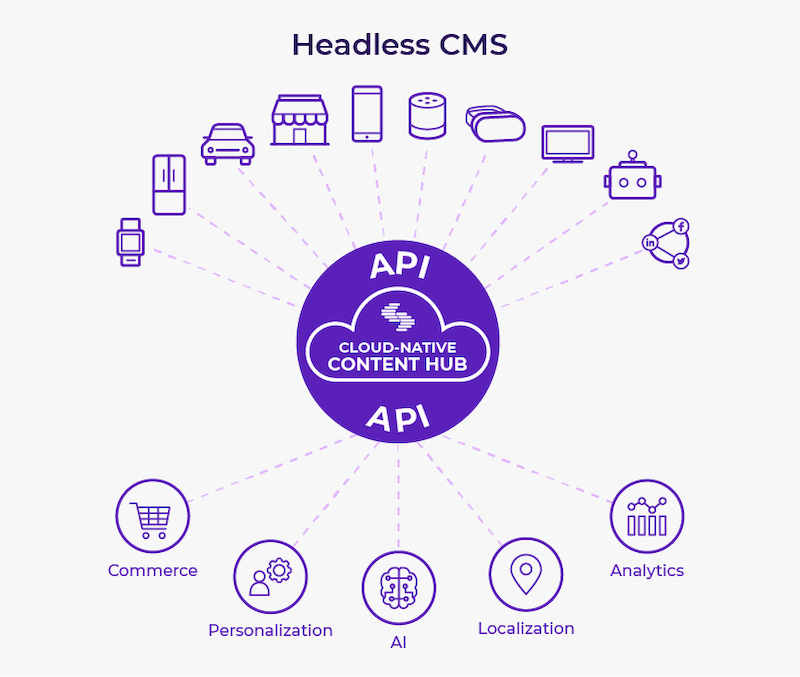Does the tech you use at your large-scale ecommerce business…
A. Empower workers to move with agility and keep you aligned with modern trends?
B. Hinder your growth and destroy any competitive edge?

If the answer is B, don’t lose hope. Today, there’s a relatively easy-to-implement technical architecture that large ecommerce brands can adopt to stay ahead of the curve.
It’s called headless ecommerce. And in this article, we’re going to explain everything you need to know about it, including:
- What the term “headless” means in relation to modern ecommerce tools
- How to tell if headless is a good fit for you
- How to introduce headless into your ecommerce business
- And more
What Does “Headless” Mean?
In the digital world, “headless” is the term used to describe an architectural style that separates the functional backend (the “body”) of an app from the frontend (the “head”) where the user interacts with the app.
Headless is one of the key features of cutting-edge MACH technology.
Microservices-based: Microservices serve modular, highly specific functionality so you have exactly the features you want, when and where you want them
API-first: Application programming interfaces (APIs) enable flexibility by easily connecting microservices to your desired endpoints
Cloud-native: Cloud infrastructure empowers businesses to scale selectively, limiting expense and downtime
Headless: As we mentioned, headless systems (like the headless content management system we’ll discuss later) separate the front-end presentation from the back-end programming to enable infinite development creativity and omnichannel delivery.
MACH technology can help enterprise businesses achieve speedy execution, pursue customer-driven outcomes, and improve upon outdated processes in a way that legacy tech simply cannot.
Diving Deeper: What Is Headless Ecommerce?
Just like other tools in the headless category, a headless ecommerce solution is one in which the back-end codebase is decoupled from the front-end features with which workers and customers interact — think multi-channel storefronts, product information and inventory management tools, marketing and sales platforms, payment systems, and more.
APIs enable all of your various systems and services to work together without becoming fully entangled. This means functionality can be updated or swapped out to keep your tech up to date. At the same time, information flows seamlessly among apps so your content is always up to date across channels, your inventory is accurate, your payments clear quickly, and everything is generally running smoothly.

4 Reasons Your Brand Must Adopt Headless Ecommerce
Legacy tech is expensive, slow, and generally failing today’s large ecommerce brands. In this section, learn more about how headless commerce can help you quickly deliver omnichannel content, easily create beautiful customer interactions, and otherwise outperform your competition in today’s cutthroat environment.
1. Update Omnichannel Content Quickly
You probably won’t be shocked to hear that retail uses more marketing channels than any other industry. And the more of these brand channels customers use, the more they shop and spend with the brand. In fact, it’s been found that omnichannel customers shop more often, spend more on each visit, and have a higher lifetime value when compared to single-channel customers.
Unfortunately, it can be tough to keep up with all the ways in which customers interact with your ecommerce channels. In the course of a single transaction, customers can visit your physical location, your website, your page or product on a marketplace like Amazon, and even your social media pages.
To be sure you’re delivering accurate content and inventory information, as well as seamless customer service throughout this complex interaction, you need a headless ecommerce system. Within a headless system, content modules can be created once and then customized endlessly so you always have flawless content ready to deliver to your chatbots, customer service knowledge base, ecommerce platforms, social sales channels, and advertising systems.
And all this content can be created, updated, and shared autonomously by your marketing team—no more putting in tickets and waiting on development support for every little publishing push.
2. Keep Up with Ecommerce Innovation
Headless ecommerce solutions are basically future-proof because they are built on microservices that are loosely held together by APIs. This makes it much simpler and faster for developers and even marketers to switch out the old and integrate the new as innovative new technologies, applications, and channels hit the market.
3. Quickly Design Beautiful Storefronts
Just like functionality isn’t permanently entangled in headless ecommerce architecture, neither is design. So as the design of your storefronts and other platforms you’ve built need to change—and they will need to change as design functionality and trends change—headless architecture makes it easy for designers and front-end developers to implement new design systems, tools, and features.
Considering that 75% of a website’s perceived credibility comes from the way it’s designed, it’s important that you prioritize an architecture that empowers you to keep your design up to date.
4. Easily A/B Test to Identify Your Most Effective Design and Content
A/B testing, the practice of continually making and comparing small tweaks in your design and content to identify improvements, can be pivotal in helping ecommerce brands learn more about their audience and grow it more successfully. A/B tests can help you uncover issues that, when fixed, do everything from improve engagement rates to grow conversions, reduce cart abandonment, and take some of the risks out of bold new updates.
While legacy ecommerce tech makes it exceedingly hard to regularly tweak tightly intertwined content and design, the ease with which fresh designs and features can be spun up on a headless platform makes A/B testing a breeze. Almost across the board, developing new, custom consumer interactions will be faster, demand fewer resources, and require less downtime after you go headless.

How to Tell if Headless Ecommerce is Right for You
While headless ecommerce is a good fit for many businesses, it’s always smart to consider your specific needs.
If you identify with any of the following points, we recommend you consider adopting a headless ecommerce system (which we’ll show you how to do in the next section):
- You’re currently experiencing or pursuing rapid growth
- Your brand has a lot of sub-brands to manage
- You need to localize content for various regions
- Your employees spend just as much time managing legacy ecommerce tools as they spend doing their actual jobs
- You can’t afford to hire enough workers to relieve the ones who are already overwhelmed with content and product updates
- Your omnichannel distribution strategy still includes too many manual steps
- Your tools—content management, marketing, inventory, customer service, etc.—aren’t integrated in a way that informs your business decisions
- You’re really focusing on keeping costs manageable (It costs 3x more to update legacy tools than to just invest in modern ones!)
Any of the above points strike a chord with you? Then it’s time to go headless. Here’s how.
How to Bring Headless Ecommerce to Your Organization
We agree with commercetools, a robust headless commerce platform, when they say that building a modern headless ecommerce architecture on a foundation of outdated, monolithic legacy tech “won’t cut it” when it comes to delivering modern experiences. That means before your ecommerce program can go headless, your whole digital experience has to. Luckily that’s not terribly hard to do when you decide to make the shift to a headless content management system (CMS).

First and foremost, headless CMS is where content—the heart of your entire digital environment—is created, stored, and managed. This feature makes it a necessary element for any headless ecommerce program that requires content (which is all of them).
But what makes headless CMS a core component upon which the rest of your headless ecommerce ecosystem can be built are its modularity and the APIs that bring these modules together. These features make the modern headless CMS a highly flexible and integrable base upon which customer relationship management, product information management, email marketing, personalization, analytics, ecommerce, and plenty of other tools can work together.
And your new headless ecommerce tech stack doesn’t have to stop there. You can get even further ahead of the curve by going all-in with an ecommerce platform that’s headless in itself (like the aforementioned commercetools) for even better integration and performance within your new headless ecommerce ecosystem.
Learn More About Going Headless Today
As you can see, there’s a whole world of opportunity out there for the large ecommerce companies that are willing to ditch the monolithic legacy tech and modernize operations with headless ecommerce architecture.
To gain more high-level knowledge on the value of content architecture when it comes to business transformation, read How Smarter Content Architecture Drives Business Transformation.
And for a more tactical example of how to develop your own flawless ecommerce experience in your new headless environment, check out our guide to Headless Ecommerce Architecture Using Contentstack and commercetools.Related Articles
Here are other CMS articles we think you'll find useful.
The Ultimate Guide to CMS Vol. 3: Use Cases for Headless Content Management Systems
In this ebook series vol. 3 of 3, we will cover seven of the most popular use cases for leveraging a headless CMS.
Read more
The Ultimate Guide to CMS Vol. 2: Content Management Systems Pros and Cons
In this ebook series vol. 2 of 3, we will discuss major advantages and disadvantages of a traditional CMS vs. a headless CMS.
Read more
Ultimate Guide to CMS Vol. 1: CMS Comparison and Architectures
In this ebook series vol. 1 of 3, we will discuss the following topics: What is a headless CMS? What is a decoupled CMS? The architectural differences between CMSes.
Read more
